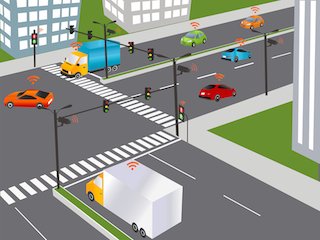In the last couple of years it’s become increasingly evident that the gradual introduction of autonomous vehicles – both personal and commercial – will have a major impact on traditional auto insurance and the commercial trucking and shipping markets.
Quadrant Information Services has recently released reports predicting the impact of autonomous/self-operating vehicles on these three markets in particular.
The expected shift from a traditional individual car ownership model to fleets of on-demand self-driving cars is detailed, as is how autonomous trucking will impact that market and how autonomous unmanned ships, guided by software, radar and other sensors – will impact the commercial shipping insurance model.
Quadrant, a premier provider of pricing analytics solutions for the P&C market, gathers, maintains, and updates the industry’s largest P&C rate sets and builds software tools and reports that enable effective comparative pricing analytics needed to make accurate, data-driven decisions.
What follows on this and the next two pages are highlights from Pleasanton, Calif.-based Quadrant about what they see coming in these three markets which are about to be disrupted by the adoption of autonomous vehicles.

Quadrant predicts surge in insurance rates as a game-changing technology begins to upend auto coverage
On September 14, car hire service Uber brought the long-predicted driverless future measurably closer when it launched its first fleet of self-driving cars on the streets of Pittsburgh.1
Concurrent with the launch came the announcement of a partnership between Uber and Swedish automaker Volvo, wherein Volvo will provide Uber with its first self-driving model, the Volvo XC90, which has left the assembly line and is now ready for testing by the public.
“This opens a new chapter in the history of automobile insurance,” said Michael Macauley, CEO of Quadrant Information Services, a leading supplier of pricing analytics services to property and casualty insurance carriers. “For more than 100 years, our industry has worked to protect the motoring public. We will continue to do so in the future, but we’ll be operating in a significantly altered landscape.”
Per the Volvo announcement, the XC90 model will be placed in the hands of Swedish drivers in 2017, followed by drivers in London and China. Volvo committed to the self-driving concept through its partnership with Uber; it has also partnered with parts supplier Automotiv to develop a software platform for autonomous driving that can be sold to other manufacturers.2
Meanwhile, other manufacturers have announced plans for the introduction of self-driving cars. Ford, for example, plans to roll out its first fully autonomous cars for ridesharing by 2021. Google is aiming for 2020, and Tesla plans to make its vehicles part of a car-sharing network once they are fully autonomous.3
The emphasis in all these announcements, Macauley noted, is on ridesharing rather than individual ownership. Both automakers and tech companies predict that the traditional car ownership model will dwindle with the rise of self-driving cars. The theory is that it will be cheaper for a consumer to just hail a driverless car than to own a personal vehicle.
Indeed, Merrill Lynch predicted in a 2015 report that driverless taxis for companies such as Uber will comprise 43% of new car sales by 2040. A somewhat more conservative estimate from the Boston Consulting Group predicted that 23% of global new car sales will come from driverless taxis by 2040, resulting in a decline in vehicle ownership, especially in cities.4
The automobile has been omnipresent for many decades, and the effects of taking the driver out of the equation will be far-reaching and, at this point, impossible to predict with any accuracy. What is clear is that it will have a disruptive effect on a number of major players, among them insurance carriers.
Early last year, in fact, publicly held companies such as Cincinnati Financial Corp., Mercury General Corp. and Travelers Cos. warned stockholders that the technology could transform consumer demand, the way policies are priced, and the patterns of crash frequency and severity that insurers use to predict their risks.5
“All of which is true,” said Macauley. “For property and casualty carriers, things are going to fundamentally change. However, that doesn’t mean that the sky is falling. Insurers may sell fewer individual policies or have to cover fewer accidents, but these more technologically advanced cars may very well be more costly to repair — against which possibility their owners will need to be insured. In the short‑ to middle-term, we’re predicting a surge in rates as the costs of this technology become more apparent.”
A major and still unanswered question has to do with liability: if somebody hits you and there’s no driver, whom do you sue? Crashes will happen, almost certainly resulting in litigation against car and software manufacturers — shifting at least some of the expense from consumer auto insurance to commercial liability policies. Macauley believes this transition will happen gradually and that there will be time to adjust and change business models as necessary.
Macauley added that the key thing is to stay abreast of events to minimize surprises. Quadrant will be staying right on top of the transition to driverless cars, and will be factoring information into calculations as fast as they come in. Insurers have a big wave of change to negotiate.
• Thoughts about how the gradual but inevitable shift to autonomous vehicles will impact insurers and agents? Please share on this thread: Autonomous transportation on the horizon
1 – Ranosa, Ted, “Uber Self-Driving Cars Hit Streets in Pittsburgh: Could This Be The End For Human-Driven Rides?”, Tech Times, September, 2016. http://www.techtimes.com/articles/177757/20160915/uber-self-driving-cars-hit-streets-in-pittsburgh-could-this-be-the-end-for-human-driven-rides.htm.
2 – Adamczyk, Ed, “Volvo builds its first self-driving car,” UPI, September 13, 2016. http://www.upi.com/Business_News/2016/09/13/Volvo-builds-its-first-self-driving-car/1181473763575/.
3 – Bigelow, Pete, “Ford Promises Fully Autonomous Cars by 2021,” Car and Driver, August 16, 2016. http://blog.caranddriver.com/ford-promises-fully-autonomous-cars-by-2021/.
4 – Muoio, Danielle, “Uber is winning the driverless race, even though it isn’t using its own cars—here’s why,” Business Insider, September 14, 2016. http://www.businessinsider.com/how-uber-is-winning-when-it-comes-to-driverless-cars-2016-9.
5 – Francis, Theo, “The Driverless Car, Officially, Is a Risk,” Wall Street Journal, March 3, 2015. http://www.wsj.com/articles/will-the-driverless-car-upend-insurance-1425428891.

Autonomous Trucking heralds change for insurers
In October 2016, a self-driving truck from San Francisco startup company Otto, a subsidiary of Uber, drove a trailer loaded with 2,000 cases of Budweiser more than 120 miles across Colorado, while the driver relaxed in the back seat. With this foray into cargo transportation, Uber announced the launch of Uber Freight, a platform to connect shippers and trucks.
“A lot of people thought it was going to happen with cars first,” said Michael Macauley, CEO of Quadrant Information Services, “but the application of this technology is much more practical for the trucking industry.”
Macauley noted that the primary motive for the impending widespread adoption of self-drive trucking is economic. Anheuser-Busch, on whose behalf the maiden Uber/Otto beer delivery was made, estimates that using fuel-efficient, self-driving trucks could lower the company’s diesel consumption by 20% to 35%, for an annual savings of $40-$50 million.2
One group not likely to benefit from autonomous trucking, noted Macauley, is truck drivers. Figures from the American Trucking Association show that there are more than three million truck drivers in the U.S., and that almost 10 million people—one of every 15 workers in the country—is employed in the trucking business on some level. There is growing concern that if commercial trucking becomes completely or even largely automated, it will be economically devastating for small towns in America that thrive by way of supporting the long-haul trucking industry.3
Nevertheless, if the technology lives up to its current promise, a large-scale disruption of the trucking industry seems not only inevitable, but already under way.
• SEE ALSO: Uber is about to kill a lot more jobs
Mining giant Rio Tinto, for example, is now using a fleet of 240-ton driverless trucks to move iron ore in two of its Australian mines, stating that it’s cheaper and safer than using human drivers. Morgan Stanley has estimated that the freight industry could save as much as $168 billion annually by harnessing autonomous technology. The projected savings would come from lower labor costs ($70 billion), better fuel efficiency ($35 billion), increased productivity ($27 billion), and fewer accidents ($36 billion).4
A wide-open question, said Macauley, is what the resulting industry might look like. The development of self-driving vehicles in recent years has been primarily a competition between technology companies and automakers working independently of each other; that dynamic changed markedly earlier this year, however, when Google announced it would expand its testing of autonomous vehicles by installing its technology in a fleet of minivans made by Fiat Chrysler. The deal was a major departure for Google, which had previously chosen to work mostly on its own in creating and testing self-driving vehicles. For Fiat Chrysler, the arrangement allows the company to gain access to Google’s expertise in driverless cars rather than develop its own technology.5
“One thing that seems certain is that the self-drive transportation industry—both trucking and non-trucking—will go through a lot of change and development before it reaches any sort of stability. Along the way, insurance carriers will need to provide coverage appropriate to the risk levels that exist at each stage, at rates that allow them to be both competitive and profitable,” said Macauley.
He admitted that for the industry, this will represent a steep—and continuous—learning curve, but said his company will be focused on providing accurate, timely data to help its customers compete in the rapidly changing environment.
• Thoughts about how the gradual but inevitable shift to autonomous vehicles will impact insurers and agents? Please share on this thread: Autonomous transportation on the horizon
1 – Isaac, Mike, “Self-Driving Truck’s First Mission: A 120-Mile Beer Run,” New York Times, October 25, 2016. http://www.nytimes.com/2016/10/26/technology/self-driving-trucks-first-mission-a-beer-run.html.
2 – Anand, Priya, “Uber’s Self-Driving Truck Just Made Its First Delivery,” BuzzFeed News, October 25, 2016. https://www.buzzfeed.com/priya/a-self-driving-uber-truck-just-made-a-beer-delivery?utm_term=.nyNdeR9Ry#.ioXl7J8J0.
3 – Markoff, John, “Want to Buy a Self-Driving Car? Big-Rig Trucks May Come First,” New York Times, May 17, 2016. http://www.nytimes.com/2016/05/17/technology/want-to-buy-a-self-driving-car-trucks-may-come-first.html.
4 – Solon, Olivia, “Self-driving trucks: what’s the future for America’s 3.5 million truckers?” The Guardian, June 17, 2016. https://www.theguardian.com/technology/2016/jun/17/self-driving-trucks-impact-on-drivers-jobs-us.
5 – Vlasic, Bill, and Boudette, Neal, “Google to get Chrysler Minivans for Self-Driving Tests,” New York Times, May 3, 2016. http://www.nytimes.com/2016/05/04/technology/google-fiat-chrysler-minivans-self-driving.html?_r=0.

Autonomous Shipping: Uncharted waters for insurers
The insurance industry, already struggling with the implications of self-driving cars and trucks, is about to be faced with a new challenge: autonomous boats.
“It will come to pass more quickly than expected,” said Michael Macauley, CEO of Quadrant Information Services. “Look at cars: a few years ago, the idea of a driverless car was regarded as science fiction. Now it’s real, and soon it’s going to be a common reality; it’s predicted that 10 million self-driving cars will be on the road by 2020.1 The same thing is happening with boats, and the insurance industry needs to start preparing for it now.”
Macauley noted that among those working to develop autonomous boating is one of the world’s best known and most advanced users of maritime technology: the United States Navy. In a demonstration by the Office of Naval Research (ONR) in Chesapeake Bay in October, 2016, autonomous unmanned boats, guided by software, radar and other sensors, displayed the ability to perform collective patrol missions using remote human supervision rather than direct human operation. “This demonstration showed some remarkable advances in autonomous capabilities,” said Cmdr. Luis Molina, military deputy for ONR’s Sea Warfare and Weapons Department. “While previous work had focused on autonomous protection of high-value ships, this time we were focused on harbor approach defense.”
The autonomy technology being developed by ONR is called “Control Architecture for Robotic Agent Command and Sensing,” or CARACaS. The components that comprise CARACaS—some of which are commercial, off-the-shelf items—are inexpensive compared to the cost of maintaining manned vessels for certain dull, dirty or dangerous tasks—and all of which can be found in the work of harbor approach defense, experts say.2
While the U.S. Navy (and navies of other nations) are intently focused on programs of this sort, military applications will probably turn out to be a relatively small and specialized niche of autonomous ship technology. Ninety percent of all world trade is carried out by the international shipping industry, and crew costs account for anywhere from 35% to 50% of the total cost of operating a container shipping vessel—providing a major cost savings opportunity for drone ships that can navigate themselves.
Full-bore autonomous deep-ocean shipping will require some capabilities that don’t yet exist. One company that is attempting to create such capabilities is Rolls Royce, which has been working on drone ship technology since 2013. Rolls Royce notes that it isn’t just labor costs that could be cut by remotely controlling a ship; the company believes that cutting out on-board infrastructure needed to support crews could result in a 12% to 15% savings in fuel costs.3
“Just as with cars and trucks,” said Macauley, “the potential financial benefits of autonomous boating and shipping are enormous. And, judging from everything we know now, so are the benefits in terms of increased safety and reliability. As the industry develops, we need to maintain an ongoing understanding of it to properly protect the people and companies affected by it.”
• Thoughts about how the gradual but inevitable shift to autonomous vehicles will impact insurers and agents? Please share on this thread: Autonomous transportation on the horizon
1 – “10 million self-driving cars will be on the road by 2020,” Business Insider, June 15, 2016.
2 – “US Navy Demonstrates Autonomous Unmanned Swarm Boats,” Marine Insight, December 20, 2016.
3 – “Drone Boats and Drone Cargo Shipping by 2025?”, Nanalyze, April 9, 2016.
About Quadrant Information Services: Quadrant Information Services, headquartered in Pleasanton, Calif., provides pricing analytics solutions for property and casualty insurance companies. Quadrant gives actuary, product development, pricing, sales and marketing personnel at its client companies—which include all the major insurance carriers in the United States—the data they need to make accurate, data-driven decisions. An industry innovator since its founding in 1991, Quadrant has provided the P&C insurance field with a long series of technological advances, including InsureWatch, the industry’s first cloud-based pricing tool, which allows the user to produce unlimited combinations of reports with the click of a mouse. For more information, and to learn why Quadrant is for insurance companies that are tired of losing the right customers and winning the wrong ones, please visit www.quadinfo.com.













